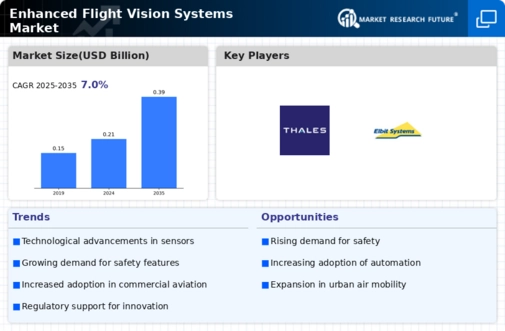Market Trends
Key Emerging Trends in the Enhanced Flight Vision Systems Market
The Enhanced Flight Vision Systems (EFVS) market is witnessing transformative trends that are reshaping the aviation industry's approach to flight vision technologies. One prominent trend is the increasing adoption of synthetic vision systems (SVS) and augmented reality displays in EFVS. These advanced technologies provide pilots with a comprehensive and intuitive view of the external environment, combining real-time data with computer-generated imagery. SVS enhances situational awareness in low-visibility conditions, allowing pilots to navigate confidently through challenging weather, terrain, and airport environments. Augmented reality displays overlay critical flight information directly onto the pilot's view, offering a seamless integration of virtual and real-world elements for improved decision-making.
The integration of infrared and thermal imaging sensors is a key trend in the EFVS market. These sensors enable pilots to see beyond the range of human vision, detecting heat signatures and providing enhanced vision in darkness, adverse weather, or other low-visibility scenarios. Infrared and thermal imaging technologies contribute to safer flight operations by detecting obstacles, wildlife, and potential hazards, especially during critical phases such as takeoff and landing. This trend underscores the industry's commitment to enhancing safety and operational capabilities through advanced sensor technologies in EFVS.
Collaboration and integration with other avionics systems are driving trends in the EFVS market. EFVS technologies are increasingly integrated with other on-board systems, such as navigation, autopilot, and terrain awareness warning systems. Collaborative efforts between EFVS providers and avionics manufacturers result in comprehensive solutions that improve overall aircraft functionality and safety. This trend reflects a holistic approach to flight vision, where EFVS is seamlessly integrated into the broader avionics architecture to provide a unified and efficient cockpit experience.
Regulatory advancements and global standardization efforts are significant trends influencing the EFVS market. Aviation authorities worldwide are recognizing the safety benefits of EFVS and are promulgating regulations to encourage its use. Regulatory bodies, such as the Federal Aviation Administration (FAA) and the European Union Aviation Safety Agency (EASA), are establishing standards and guidelines for EFVS implementation. These regulations are driving the adoption of EFVS across different aircraft categories, fostering a consistent and standardized approach to enhanced flight vision systems in the industry.
Cost-effective solutions and the scalability of EFVS technologies are emerging trends in response to the varying needs of different aircraft types and operators. EFVS providers are developing solutions that cater to a broad spectrum of aircraft, from general aviation to commercial and military applications. This trend allows operators to choose EFVS solutions that align with their specific requirements and budgets, fostering a more accessible and diverse market for enhanced flight vision systems.
Technological innovations in lightweight and compact EFVS hardware are shaping the market's trends. Advancements in materials and manufacturing processes are resulting in smaller, lighter, and more energy-efficient EFVS components. These innovations contribute to easier integration into different aircraft models, reduce installation complexity, and address concerns related to weight and power consumption. The trend towards lightweight and compact EFVS solutions supports a broader range of aircraft applications and facilitates retrofitting on existing fleets.






Leave a Comment